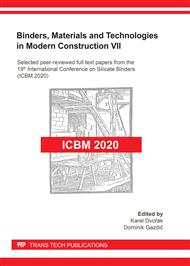p.125
p.131
p.137
p.143
p.150
p.156
p.162
p.168
p.174
Cement-Bonded Sub-Base Layers of Walkable and Running Structures for Rainwater Management
Abstract:
Sub-base layers of walkable and running road structures usually consist of a stable subsoil with sufficient load-bearing capacity under the surface layer itself in the form of concrete covers or prefabricated paving elements. Due to their load-bearing capacity, these sub-base layers are most often constructed using cement-bonded aggregate technology. The current hot topic of rainwater management brings opportunities for the construction of water-permeable structures with good water retention capacity. The retention capacity of such a structure can be ensured in ideal conditions by making this sub-base partially permeable and with an absorbent layer while maintaining its mechanical advantages. The experiment confirmed the possibility of producing cement-bonded sub-base layers using light porous aggregates based on expanded clays. The high absorption rate of the type of aggregate used is a good starting point for increasing the retention capacity of the entire system.
Info:
Periodical:
Pages:
150-155
Citation:
Online since:
October 2021
Authors:
Price:
Сopyright:
© 2021 Trans Tech Publications Ltd. All Rights Reserved
Share:
Citation:


